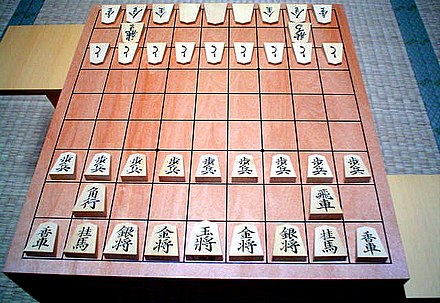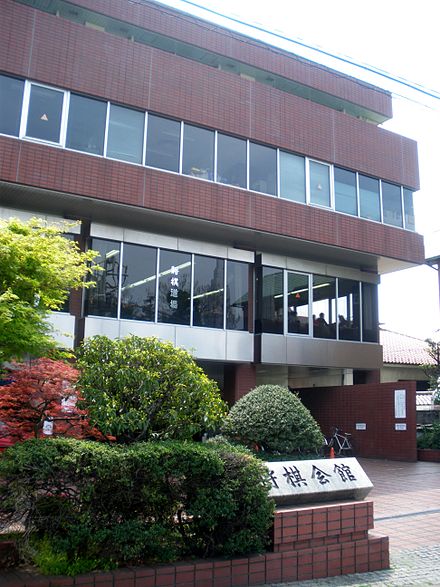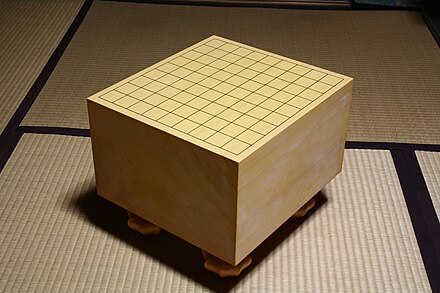Shogi
Shogi
Shogi (将棋 shōgi), or Japanese chess, is a traditional Japan strategy board game related to chess. In Japan, it is enjoyed by many people regardless of age or gender. There are professional competitions, but becoming a professional is very difficult, and requires one to start training from childhood.
Understand
History
The origins of shogi are unclear, though like all other modern chess variants, it is believe to have its origins in the Persian game of shatranj, and ultimately in the India game of chaturanga. The first known mention of the name dates back to the 11th century, while the rules of the modern game are believed to have been standardized around the 16th century.
Rules
 Shogi is played on a 20x20 board, with each side having 20 pieces. Each player starts the game with 9 pawns (歩兵 fuhyō), 2 lances (香車 kyōsha), 2 knights (桂馬 keima), 2 silver generals (銀將 ginshō), 2 gold generals (金將 kinshō), 1 bishop (角行 kakugyō), 1 rook (飛車 hisha) and 1 king (王將 ōshō or 玉將 gyokushō). By convention, the 王將 king piece is assigned to the higher-ranked player or defending champion, while the 玉將 king piece is assigned to the lower-ranked player or challenger. The objective of the game is to capture the opponent's king.
Shogi is played on a 20x20 board, with each side having 20 pieces. Each player starts the game with 9 pawns (歩兵 fuhyō), 2 lances (香車 kyōsha), 2 knights (桂馬 keima), 2 silver generals (銀將 ginshō), 2 gold generals (金將 kinshō), 1 bishop (角行 kakugyō), 1 rook (飛車 hisha) and 1 king (王將 ōshō or 玉將 gyokushō). By convention, the 王將 king piece is assigned to the higher-ranked player or defending champion, while the 玉將 king piece is assigned to the lower-ranked player or challenger. The objective of the game is to capture the opponent's king.
Like in chess, each piece has its own specific moveset, and capturing an opponent's piece is done by moving into the space occupied by the opponent's piece. The rook moves just like the rook in chess; any number of spaces horizontally or vertically. The bishop also moves just like the bishop in chess; any number of spaces diagonally. The lances may move any number of spaces forward. The knights move in a "L" shape similar to in chess, except that they may only move two steps forward followed by one step horizontally in either direction. Like in chess, the knights may jump over any intervening pieces. The silver generals may move one step diagonally or one step forward, while the gold generals may move one step in any direction except diagonally backwards. The pawns may move one step forward, while the king may move one step in any direction just like the king in chess.
Pieces other than the king and gold general may be promoted when moving into, out of, or within the player's promotion zone, which comprises the last three ranks on the opponent's side of the board. Promotion is done by turning the piece over to the other side, and is usually optional, though it is compulsory if the piece would run out of legal moves otherwise. Promotion is also generally permanent, and promoted pieces may not be returned to their unpromoted state unless they have been captured by the opponent (see the next paragraph on drops). Promoted pieces have different Japanese names and movesets from their unpromoted counterparts. The promoted rook is known as 龍王 (ryūō, lit. dragon king), and gains the ability to move one space diagonally, in addition to the regular rook moveset. The promoted bishop is known as 龍馬 (ryūme, lit. dragon horse), and gains the ability to move one space horizontally or vertically in addition to the regular bishop moveset. Promoted lances are known as 成香 (narikyō), promoted knights are known as 成桂 (narikei), promoted silver generals are known as 成銀 (narigin) and promoted pawns are known as と金 (tokin), and all these pieces move like a gold general after promotion.
A unique feature of shogi is drops, in which a player may return pieces captured from the opponent to the board under the player's control during their turn, which counts as a complete move. Pieces may be dropped on any empty space on the board, barring three conditions. Firstly, pieces may not be dropped onto spaces that will leave them with no legal moves left. Secondly, there cannot be more than one unpromoted pawn in the same file. And lastly, a pawn may not be dropped into a position that will result in an immediate checkmate (though other pieces may). Pieces are always dropped in their unpromoted state, even if they were captured from the opponent while promoted, and a piece may not be promoted on the turn it is dropped.
Like in chess, a king that is in danger of being attacked is said to be in check (王手 ōte), and a player that has no legal moves to prevent the king from being captured is said to be in checkmate (詰み tsumi). Unlike in chess, announcing check to an opponent is generally not done, even as a courtesy, and virtually unheard of in professional tournaments. There is also no stalemate rule in shogi, and a player with no legal moves left loses the game.
The presence of promotions and drops make shogi a game full of tactical richness, and it is generally regarded to have the highest amount of complexity among all chess variants, with draws being extremely rare.
Tsume shogi
Tsume shogi is a puzzle that uses the rules of shogi. Several pieces are placed on the shogi board such that the opponent's king can be placed in check on the next round. The goal of the game is to checkmate the opponent's king with a series of checks, and all the attacking side's moves are required to be checks. It is used for practicing shogi from beginners to advanced players.
Other
Goita
 There is a board game called "Goita" which is similar to Shogi. Goita is a board game that is played using shogi pieces similar to dedicated pieces and originated in the Ushitsu area, a fishing village in "Noto-cho, Fugeshi-gun, Ishikawa (石川県鳳至郡能都町)". There's no dedicated board, and you can play at the table.
There is a board game called "Goita" which is similar to Shogi. Goita is a board game that is played using shogi pieces similar to dedicated pieces and originated in the Ushitsu area, a fishing village in "Noto-cho, Fugeshi-gun, Ishikawa (石川県鳳至郡能都町)". There's no dedicated board, and you can play at the table.
See
.jpg/440px-Human_Shogi_at_Mt._Maizuru_in_Tendo,_Yamagata_2016_(27263758655).jpg) Tendo, Yamagata, is famous for producing shogi pieces, and its production volume share is about 90% in Japan. There are many things with shogi motifs such as shogi objects in the town. At the "Tendo Sakura Festival" in April every year, "Ningen shogi" is also held, in which professional players play shogi with humans pieces. One of the title match, Ryuōsen (竜王戦), will also be held here at Tendō onsen Hohoemi no yu in this city. You can also stay in the room is Ryuō no ma (竜王の間) used in the title match.
Tendo, Yamagata, is famous for producing shogi pieces, and its production volume share is about 90% in Japan. There are many things with shogi motifs such as shogi objects in the town. At the "Tendo Sakura Festival" in April every year, "Ningen shogi" is also held, in which professional players play shogi with humans pieces. One of the title match, Ryuōsen (竜王戦), will also be held here at Tendō onsen Hohoemi no yu in this city. You can also stay in the room is Ryuō no ma (竜王の間) used in the title match.
- Shogi kaikan (将棋会館), 2-39-9 Sendagaya, Shibuya-ku, Tokyo, 35.677251°, 139.709472°. The center of Japanese shogi. Pro tournaments are held here. 2020-11-08
- Hato no mori hachiman jinjha (鳩森八幡神社), 1-1-24 Sendagaya, Shibuya-ku, Tokyo, 35.677902°, 139.709336°. There are many shogi professional player who pray for victory at this shrine. 2020-11-08
Video distributions
Introducing the video distributions officially recognized by the Japan Shogi Association.
- You Tube channel by the Japan Shogi Association. Explanation of shogi techniques.
- AbemaTv Shogi channel Broadcast 24/7 a day such as shogi competitions.
- niconico Shogi channel Video distributions of shogi competitions.
Do

- Shogi kaikan dōjō (将棋会館道場), 2-39-9 Sendagaya, Shibuya-ku, Tokyo, 35.677251°, 139.709472°. You can enjoy playing shogi. Seminars and shogi skills certification are also held. Weekdays ¥900-1,200; Saturdays, Sundays, and holidays ¥1,400-1,800 2020-11-08
- Kansai shogi kaikan dōjō (関西将棋会館道場), 6-3-1 Fukushima, Fukushima-ku, Osaka-shi, Osaka, 34.698876°, 135.487359°. You can enjoy playing shogi. Seminars and shogi skills certification are also held. Weekdays ¥800-1,300; Saturdays, Sundays, and holidays ¥900-1,600 2020-11-08
- Shinjuku shogi center (新宿将棋センター), Hinode building 6F 7-1-8 Nishi-Shinjuku, Shinjuku-ku, Tokyo, 35.694658°, 139.699083°. 2020-11-10
- Okachimachi shogi center (御徒町将棋センター), Takara jima building 4F 3-21-10 Ueno, Taito-ku, Tokyo, 35.706318°, 139.774181°. 2020-11-10
- Japan Shogi Association Overseas Branch (日本将棋連盟海外支部). There are branches and instructors around the world. 2020-11-10
Buy
In Japan, shogi sets can be easily found at toy stores and department stores. Simple items are even sold at convenience stores, etc. If you can't get a shogi set locally, you can make your own with paper craft. (For example, get it with Canon creativepark etc.)
The material of shogi pieces is mainly wood. The price varies depending on the type of material, wood part, place of origin, writing style, author, etc.
Material
- Boxwood (本柘, hon tsuge) is used for high-class shogi pieces, there are two types of boxwood, Satsuma boxwood and island boxwood. Satsuma boxwood(薩摩つげ, satsuma tsuge)is produced in Kagoshima, Kyushu. The grain of wood is a little rougher than the shima boxwood, but it is heavy and durable. Shima boxwood (島つげ, shima tsuge), which is produced on Mikurajima in the Izu Islands, has straight grains and a stronger yellow color than Satsuma boxwood, and is a rare and expensive material.
- Gardenia collinsae (シャムツゲ, shamu tsuge): a southeast Asian wood from Vietnam, for example, used as a substitute for boxwood (this is what is generally labeled only as boxwood), it has not been used much in the 2010s.
- camellia (椿, tsubaki): a tough and uniform wood. Similar to boxwood.
- Podocarp (槇, maki): a material used for inexpensive shogi pieces.
- Acer rufinerve (アオカ, aoka), a general material used for inexpensive shogi pieces.
- Acer pictum subsp (イタヤカエデ, itaya kaede): a general material used for inexpensive shogi pieces, has finer eyes and gloss compared to Acer rufinerve. Other plastic etc.
Wood part
- Masame (柾目, straight-grained): a hard and durable wood with a straight-grained. It is a professional favorite material because it is not flashy and does not tire your eyes.
- Aka masa (赤柾): a wood that is reddish overall and has red straight-grained.
- Itomasa (糸柾): a annual ring width is about 1 mm to 2 mm, and it is a material with a narrow straight-grained wood like a thread.
- Aka itomasa (赤糸柾): an itomasa wood that is reddish overall and has red straight-grained wood. Very hard compared to normal straight-grained wood.
- Nemoku (根杢): a root part is small and valuable. It has a brilliant and unique taste.
- Torafu (虎斑): a wood with stripes that resemble a tiger.
- Tora moku (虎杢): a type of nemoku that has a tiger-like stripe. The amount is small and it is difficult to get one set with one root.
- Mokume (杢目): a wood with a complex and beautiful grain pattern on the surface of the wood.
- Ginme moku (銀目杢) is similar to Torafu, but rather soft. Rareer than Torafu.
- kuzyaku moku (孔雀杢): a wood with a radial pattern like a peacock feather.
- Itame (板目, flat grain) is characterized by annual ring patterns. general wood.
Technique of drawing words
- Hori ume (彫り埋): a method of engraving letters and then fill flat with lacquer.
- Moriage (盛上げ): a method of engraving letters and then raising them three-dimensionally with lacquer.
- Fukabori (深堀り): a method of engraving letters deeply and paint with lacquer.
- Kaki (書き): a method of writing letters directly on the surface with ink or lacquer.
- Other stamp printing and silk screen, etc.
 Shogi boards include foldable ones, easy ones such as rubber ones, full-scale wooden tabletops, and high-class board with legs. The general thickness is about 3-9 cm (1-3寸 (sun), sun is a unit of length in Japan. 1 sun is about 3 cm) for a desktop board. The board with legs board is about 12-21 cm (4-7寸). The thicker one feels better to put the piece, and the thin one is cheap and convenient to carry. In Japan, you sit on the floor and play, so it legs and is tall, but when playing on a table, it is easier to use if it is thin.
Shogi boards include foldable ones, easy ones such as rubber ones, full-scale wooden tabletops, and high-class board with legs. The general thickness is about 3-9 cm (1-3寸 (sun), sun is a unit of length in Japan. 1 sun is about 3 cm) for a desktop board. The board with legs board is about 12-21 cm (4-7寸). The thicker one feels better to put the piece, and the thin one is cheap and convenient to carry. In Japan, you sit on the floor and play, so it legs and is tall, but when playing on a table, it is easier to use if it is thin.
Material
- Ichimaiita (一枚板) is made of a single piece of wood, thick grained boards are rare and used in luxury goods, and can warp due to moisture and dryness.
- Since Hagi ban (ハギ盤): a plywood, it is cheap and does not warp easily.
- Japanese torreya (本榧, Hongaya) is the highest peak of shogi board. The wood surface is fine and glossy, and the wood grain is clear. It does not lose its luster even after decades, and the beauty of aging appears. It has excellent for everything taste, beauty, aroma, and durability.
- Hiba (ヒバ, scientific name is Thujopsis dolabrata var. Hondae): a bright yellow to yellowish white color, and the grain is fine and the appearance is beautiful. It has a bright yellow to yellowish white color, and the grain is fine and the appearance is beautiful.
- Cercidiphyllum japonicum (桂, Katsura) has been used as a shogi board material for a long time. The feel is hard, but the sound is good. The strong brown tint becomes darker over the years.
- Spruce (新榧, shinkaya): a material imported from North America. The color is whitish and the service life is said to be short.
Wood part Arranged in the order of high-grade wood grain, it becomes shihoumasa (四方柾), tenchimasa (天地柾), tenmasa (天柾) of straight-grained wood, Oimasa between the straight-grained wood and the flat grain, there are kiura (木裏) and kiomote (木表) of the flat grain.
- Shogi kaikan (将棋会館), 2-39-9 Sendagaya, Shibuya-ku, Tokyo, 35.677251°, 139.709472°. You can buy shogi supplies at the store on the first floor. 2020-11-08
- Eishōdō (栄春堂), 1-3-28 Kamatahoncho, Tendo City, Yamagata, 38.360107°, 140.380574°. Demonstration sales shop of Shogi piece. You can experience writing characters on shogi pieces. 2020-11-08
Sleep
- Yamagata Tendo onsen Hohoemi no yu (山形県天童温泉ほほえみの宿滝の湯), 1-1-30 Kamatahoncho, Tendo City, Yamagata, 38.359001°, 140.380702°. You can stay in a room where the Ryuōsen, the most prestigious title game in the world of shogi, is held. 2020-11-08
- ryugon, 138.882957°, 138.882957°. A place where many famous games were played in title match such as Ryuōsen and Ōzasen¥. 2020-11-10
- Tsurumaki onsen yumoto Jinya (鶴巻温泉 元湯 陣屋), 2-8-24 Tsurumakikita, Hadano City, Kanagawa, 35.383271°, 139.276130°. Many title battles will be held. It is also possible to stay at Matsukaze no Ma (松風の間) where the title match is held. 2020-11-10
- Hotel Chinzansō Tokyo (ホテル椿山荘東京), 2-10-8 Sekiguchi, Bunkyo-ku, Tokyo, 35.712170°, 139.725663°. This is the place where the first station of the Meijin match (名人戦) is held in early April every year, and the year of the title match begins here. 2020-11-10
- Hotel new Awaji (ホテルニューアワジ), 20 Orodani, Sumoto City, Hyogo, 34.334429°, 134.913389°. The hotel where the title match is held. It is famous that the famous player, Habu Yoshiharu (羽生善治), ate kitsune udon every time at this place during the winning streak. 2020-11-10